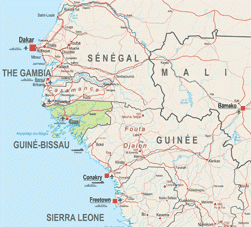Guinea-BissauDownload light PDF version
Overview
Guinea-Bissau was in the middle of holding presidential elections when the military seized power and arrested the country's interim president as well as the leading candidate in the on-going elections. The 12 April 2012 military coup is the most recent episode in a long history of political tumult in Bissau. Since its independence from Portugal in 1974, no elected president has managed to complete his full mandate. ECOWAS mediation, coupled with economic and diplomatic sanctions, helped persuade the junta to quickly hand over to a transitional government. The regional organisation is also spearheading a process of defence and security sector reform in Guinea-Bissau. Meanwhile, the interim government, led by Interim President Manuel Serifo Nhamadjo, is working to set the country back on the path to democratic rule, though the process has not been entirely smooth. Following delays due to financial and technical difficulties, legislative elections are scheduled to take place in March 2014.
Guinea-Bissau is one of the three smallest countries in West Africa (36 000 km2), ranking after The Gambia (11 000 km2) and Cape Verde (4 000 km2). No part of its territory is more than 50 km away from one of its borders. Its economy is strongly oriented towards southern Senegal and, to a lesser extent, The Gambia. Its extensive trade with these two francophone countries was undoubtedly one of the primary reasons it decided to join the West African Economic and Monetary Union (UEMOA) and adopt the CFA franc in 1997 despite not being francophone itself.
Guinea-Bissau’s political turmoil and weak economy have made it vulnerable to South American drug cartels, who chose the country as the relay point in traffic towards Europe in the early 2000s. The challenge of drug trafficking in Guinea-Bissau has has serious regional implications. Not only has the network of traffickers spread throughout the region, but the existing drug and arm trafficking feed off one another and the drug trafficking network has, at least indirectly, helped finance some AQIM cells. Current measures executed by the government in conjunction with the UN Office on Drugs and Crime (UNODC) include: training judges for drug-related cases, increasing the number of drug-related investigations and providing offender rehabilitation. Guinea-Bissau’s Transnational Crime Unit (TCU) was also cited as a key organisation involved in anti-drug trafficking efforts. It is part of the West Coast African Initiative (WACI), a partnership between UNODC and the UN Office for West Africa, among others, that was meant to provide support for regional efforts against organised crime.
Institutional Framework
| Government type: | Republic |
| Constitution: | |
| Legal system: | mixed legal system of civil law (influenced by the early French Civil Code) and customary law |
| Administrative divisions: | 9 regions (regioes, singular - regiao); Bafata, Biombo, Bissau, Bolama, Cacheu, Gabu, Oio, Quinara, Tombali; note - Bolama may have been renamed Bolama-Bijagos |
| Executive branch: |
|
| Legislative branch: | Unicameral National People's Assembly or Assembleia Nacional Popular (100 seats; members elected by popular vote to serve four-year terms) |
| Judical branch: | Highest court(s): Supreme Court of Justice (consists of 9 judges and organized into Civil, Criminal, and Social and Administrative Disputes Chambers) note - the Supreme Court has both appellate and constitutional jurisdiction |
| Political parties: |
|
| Suffrage: | 18 years of age; universal |
| Elections: | president elected by popular vote for a five-year term (no term limits); election last held on 18 March 2012 with a runoff between the two leading candidates scheduled for 22 April 2012; prime minister appointed by the president after consultation with party leaders in the legislature |
| Election results: | with no candidate receiving a minimum 50% of the vote in the first round, a runoff between the two leading candidates was scheduled for 22 April 2012; percent of vote (first round) - Carlos GOMES Junior 49.0%, Kumba YALA 23.4%, others 27.6 |
| Central bank: | BCEAO |
| Military branches: | People's Revolutionary Armed Force (FARP): Army, Navy, National Air Force (Forca Aerea Nacional); Presidential Guard (2012) |
| Military age and obligations: | 18-25 years of age for selective compulsory military service (Air Force service is voluntary); 16 years of age or younger, with parental consent, for voluntary service (2013) |
| Membership in regional organisations: | AfDB, AU (suspended), BOAD, ECOWAS, UEMOA |
Regional Indicators
Land boundaries: | 724 km |
| Border countries: | Guinea 386 km, Senegal 338 km |
| Coastline: | 350 km |
| Airports: | 8; with paved runways: 2 (2013) |
| Roadways: | 3 455 km; paved: 965 km, unpaved: 2 490 km (2002) |
| major seaports: | Bissau, Buba, Cacheu, Farim |
| Source: CIA Factbook, Country Profile Guinea-Bissau | |
Food Security
| Global Hunger Index (IFPRI, 2011): | 19.5 |
| Food supply (kcal per capita/day) | 2 288 |
| Number of people undernourished: | - |
:Percentage of people undernourished: | - |
| Child malnutrition, underweight: | - |
| Child malnutrition, stunting: | - |
Land use
| Land area (1 000 ha): | 2 812 |
| Agricultural land area (1 000 ha): | 1 630 |
Arable land (1 000 ha): | 300 |
| Permanent crops (1 000 ha): | 250 |
| Pastures (1 000 ha): | 1 080 |
| Irrigated land (1 000 ha): | 25 |
| Share in total water use by |
|
| Forest area (1000 ha): | 2 022 |
Source: FAOStat and FAO Country Profile FAO Country Profile

